Part 1 - Out to the Lighthouse
By midweek before the ride, I was pretty much resigned to staying soaked all day long.
It was sort of freeing, really. Felt like I was under-miled a bit, as mentioned earlier, and the forecast continued to become more robust through the weekend, until the chance of rain stood firmly at 90% for Saturday. Thursday evening, a very wet storm parked itself over the greater SF Bay Area, and started dropping rain in serious quantities. By Friday evening, the local alerts started coming over the cable - flood warnings through Ross, San Anselmo and Fairfax - which are three of the Marin County towns in the initial/final bits of the SF Randonneurs 200K brevet route.
Still, I didn’t think about not showing up. My wife (wisely) kept giving me polite, “are you sure?” looks during those worst moments of the storms and forecasts. But, one of the nice things about county-specific local knowledge is that you know those floods are tidally influenced - the Corte Madera Creek gets a lot of water from the SF Bay at high tide, and the SF Bay in turn gets a lot of water from the rivers when it rains. At high tide, the water simply has nowhere to go and spreads wide through the floodplain until the moon’s influence is lessened, and everything gets pushed out to sea through the Golden Gate.
On the other hand, the low spots in our backyard had 6-8″ of water in ‘em, the rain pounded our roof, and the sump pump kept hammering away. It was gonna be wet. As I said, I was resigned to it.
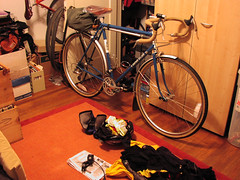 So, I’d become water-imperviousness-obsessed all week - treating everything that had a seam with silicone spray, getting a waterproof cover for the Country Bag, rigging a heavy plastic bag on the Brooks, pulling some obvious bolts and regreasing ‘em, double-checking the fender and flap coverage, cleaning the drivetrain and breaking out the Phil’s Tenacious Oil. I bought a bunch of those chemical handwarmers and packed a baggie with an extra pair of socks and shorts - figuring that the mental uplift of dry toes and bits would be helpful at some point. I was convinced it would be a long, wet day.
So, I’d become water-imperviousness-obsessed all week - treating everything that had a seam with silicone spray, getting a waterproof cover for the Country Bag, rigging a heavy plastic bag on the Brooks, pulling some obvious bolts and regreasing ‘em, double-checking the fender and flap coverage, cleaning the drivetrain and breaking out the Phil’s Tenacious Oil. I bought a bunch of those chemical handwarmers and packed a baggie with an extra pair of socks and shorts - figuring that the mental uplift of dry toes and bits would be helpful at some point. I was convinced it would be a long, wet day.
Woke up with a jolt about three in the morning. It took a while to figure out what had triggered my awakening. The dogs were asleep and nothing seemed out of order. Then I realized - it was dead quiet. No rain. I bumped to the back door and confirmed. Not even a light mist. This was most unexpected.
Two hours later, when the alarm went off, the same conditions prevailed. Going outside with the dog made it clear that it had actually even warmed a bit - the air was clearly not as chilly as it had been for the past couple weeks. These were interesting developments. The only immediate change was to ditch the extra shorts and hat.
I made some sandwiches, fed the dog and hit the road. Still no rain.
Exiting the car at the north end of the Golden Gate Bridge, the clouds were high and and pavement had even dried a bit here and there. I decided to forgo the newly-siliconed booties, leaving them in the car, but kept the Rainlegs rolled up around my waist. Locked up and rolled off to the start, headlight stabbing into the dark.
It’s a beautiful time to be up and about. There is something about rolling silently along while most of the world is asleep that brings a happy tingle to my being. The lists and tasks of the week fell away as gravity pulled me down the subtle arc of the bridge toward the start of the San Francsico Randonneurs 2008 200K brevet. It was time to ride.
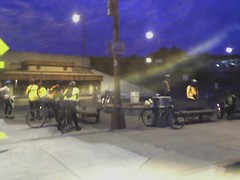 In contrast to last year, it was a sparse group gathered near the statue. The 2007 ride, being a PBP year, had drawn a sellout crowd. This year, I actually was concerned that the ride was starting somewhere else. I rolled down to an adjacent parking lot, signed in and obtained my brevet card - very carefully stowed it - and returned to the gathering spot. Other riders rolled up and a group seemed to coalesce. Still, it was not going to be huge bunch. According to the SFRandonneurs site, 89 riders had signed up, but it didn’t look like more than 40 had shown. (Turned out to be 32).
In contrast to last year, it was a sparse group gathered near the statue. The 2007 ride, being a PBP year, had drawn a sellout crowd. This year, I actually was concerned that the ride was starting somewhere else. I rolled down to an adjacent parking lot, signed in and obtained my brevet card - very carefully stowed it - and returned to the gathering spot. Other riders rolled up and a group seemed to coalesce. Still, it was not going to be huge bunch. According to the SFRandonneurs site, 89 riders had signed up, but it didn’t look like more than 40 had shown. (Turned out to be 32).
On brevets, the first thing you learn is that the clock never stops, and as the second hand brought us closer to depart time, new RBA Rob Hawks welcomed us, gave us some rudimentary warnings about the potential for flooding and similar road hazards, and sent us off onto the ride precisely at 7 am.
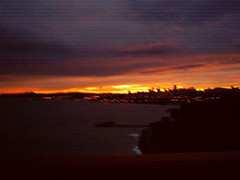 A couple riders moved away quickly, but most stayed grouped together as we rolled north on the bridge. The morning’s sunrise had just started to light up the sky, and it burned with an unfamiliar orange. Even in these first few miles, it felt as if we’d picked up a mild tailwind. Dropping down into Sausailto, there was visible chop on the water - not the thing you really want to see that early in the morning. Though so far, the weather service had been pessimistic on the precipitation, they’d called the wind direction completely right. South-Southeast.
A couple riders moved away quickly, but most stayed grouped together as we rolled north on the bridge. The morning’s sunrise had just started to light up the sky, and it burned with an unfamiliar orange. Even in these first few miles, it felt as if we’d picked up a mild tailwind. Dropping down into Sausailto, there was visible chop on the water - not the thing you really want to see that early in the morning. Though so far, the weather service had been pessimistic on the precipitation, they’d called the wind direction completely right. South-Southeast.
We stayed mostly bunched, hit the traffic lights right and kept on rolling. I kept opening my jacket, but felt warmer - almost overdressed - with the wind at our backs. As we turned into the Camino Alto climb, I took off my gloves, which were already starting to soak through with sweat. I picked an easy pace on the climb, making sure that I stayed comfortable, that all the joints were articulating correctly and that the bike hadn’t developed any new noises. Carlos and JimG eased away on that first climb, with a few folks connected to them. I could hear other riders behind me. Things felt right.
One of the points that Rob had mentioned before the start was that the first 2/3rds of the route sheet covered the first 20 miles. He asked if there were any riders familiar with that section - what we call variously “the commute route” or “the southern marin maze” - many of us raised our hand. He then instructed anyone who didn’t know that portion to pay attention to those of us who had raised our arms. Whatever else this brevet tested, it wasn’t my ability to follow a printed cue list. And in my best John Lovitz voice, it made me “popular, yeah!..that’s it!”
I soon realized that I’d collected my own little flock of riders. Met and chatted a little with John-from-Cool (that’s a geographic reference), who had openly admired my tweed mudflaps. We all stayed together as the route wanderered through a few less travelled zones of southern marin. Rolling through downtown San Anselmo, I kept my eye out for flotsam which might have been left behind by the previous night’s flooding. Little to speak of, and the news camera crew trucks hovered dejectedly around the old downtown bridge, trying to get an interesting angle of muddy water going downstream for their producers. Most of the businesses had plastic sheeting and sandbags set up against the possibility of seriously rising waters. Yet, it appeared that the town had avoided a replay of 1982 and 2005/6.
We all continued onward, wiggling through the sidestreets and turns that make up that confusing part of the route. Before long, we’d reached Fairfax and the left turn onto Sir Francis Drake Blvd., leaving stop signs and course aberrations behind for a while. Most of the route had been reasonably sheltered, but you could feel the subtle assist of a tailwind pushing us north-northwest.
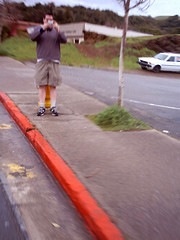 A whoop and a hoot caught my attention as we left downtown Fairfax. Up ahead on the right stood Mike Biswell, who had volunteered to cover the Pt. Reyes Lighthouse Control. He snapped photos of us as we rolled past. It was odd and reassuring to see someone we knew out on the course. After the fact, I fretted briefly that it had been a secret control, but discounted that thought pretty quickly as we continued the mild incline that took us out of town and up to White’s Hill.
A whoop and a hoot caught my attention as we left downtown Fairfax. Up ahead on the right stood Mike Biswell, who had volunteered to cover the Pt. Reyes Lighthouse Control. He snapped photos of us as we rolled past. It was odd and reassuring to see someone we knew out on the course. After the fact, I fretted briefly that it had been a secret control, but discounted that thought pretty quickly as we continued the mild incline that took us out of town and up to White’s Hill.
White’s Hill is a significant climb. I think it has a lot to do with where it is on the course, and the nature of the location. It is the climb which leaves the towns of southern marin county behind, so it’s always a landmark for me. It’s really the first time on the course that you have to knuckle down to go up. I’m sure that on some routes, its pitch and length might barely be noted, but for me, it’s a good test of how I’m feeling on a given day. The previous week, it had fought back pretty well, and I watched other folks ride away without all that much trouble.
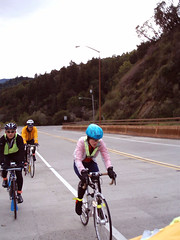 Today it went pretty well. I’d actually ridden very little the week prior to the brevet, and felt downright strong as the road went up. Of course, that can be a little misleading and self-congratulatory. There are countless times when I felt great and powerful on a climb, only to have a small group overtake me as they easily chatted and spun past - me leaking exhaust like a homebuilt steam engine at a distressingly low cadence. On this morning, the breathing of those around me sounded about the same as my own, and we crested out and head down into the San Geronimo valley.
Today it went pretty well. I’d actually ridden very little the week prior to the brevet, and felt downright strong as the road went up. Of course, that can be a little misleading and self-congratulatory. There are countless times when I felt great and powerful on a climb, only to have a small group overtake me as they easily chatted and spun past - me leaking exhaust like a homebuilt steam engine at a distressingly low cadence. On this morning, the breathing of those around me sounded about the same as my own, and we crested out and head down into the San Geronimo valley.
The breeze of the descent dries things fairly quickly, and my temperature drops from mildly overheating to just about right. The tailwind nudges us along and I find myself in front of the bunch again. It is mildly distressing, as it’s oftentimes easier to just follow a wheel than set the pace. But, I take the opportunity to smooth myself out and follow some of Jan Heine’s advice - rolling on the fog stripe.
On most of the roads in these parts, there’s a solid painted line which defines the right hand side of the lane. By positioning your tires on this, the ride is noticeably smoother than regular asphalt. It generally helps to keep your tires out of roadside debris as well. Since the roads were a bit wet still, tire adhesion was not optimum, but with the 33 1/3 mm meat of the Jack Brown tires, it was well within the comfort zone. Pedaling along, a phrase surfaced in my brain, “What small efficiency can you find?” It seemed like a helpful mantra, so I tried to put it into action - hands on the top, fingers relaxed, shoulders calm, sure the legs were spinning, but no reason everything else couldn’t be placid. By the end of the open/straight part of the valley, things seemed pretty good. It was a helpful thought to hold onto.
The turns began at the Lagunitas end of the valley, and the road was downright wet here under the tree cover. I’d figured on skipping the unpaved portion of the cross-marin path, but still wanted to use the section at Samuel P. Taylor State Park to bypass the narrow, bumpy section of the roadway. We passed the Inkwells Bridge cutoff and continued on the road. It was my plan to let someone else set the pace and then politely drop off the back at the old rail overpass. However, the gang seemed pretty content with the pace I was setting, and by the time we were easing down toward that point, they were politely behind me. I tried to sit up in an obvious way and pull to the right, then said, “I’m going to take the path here..” and peeled right to the trail entrance.
With the added perspective of a few days after the ride, this may not have been the smartest move of the day. We had whittled down to a group of four, and were moving along pretty well together. One rider seemed to pause more than the others, and I could see her contemplating following my move, before standing on the pedals and hightailing it after the other two. I felt a little bad about wrecking the momentum of the gang.
There was still a half mile connector to the paved part, and I immediately encountered a tree which had fallen across the roadway. Luckily, the top lay just off the road on the right, and a walkable path was easily found. I remounted, slid a little here and there on my way through the saturated muddy ground. Soon I was on the paved bits, paralleling the “historic” section of Sir Francis Drake Blvd. Before I knew it, the path ended and the climb up from Tocaloma appeared. This incline jumps over the low point of the Bolinas Ridge to Olema. Up in the distance, I could see some riders’ taillights and the bright orange swatch of what I took to be Carlos’ jacket. About midway up, a non-brevet rider passed with some degree of authority. The climb began warming me up, so I pulled my jacket up to keep comfy, soon cresting out and dropping down the other side.
As I rolled towards the Pt. Reyes Seashore visitor center in Bear Valley, I slipped my phone out of my pocket to check the time. The readout said 9:08, and I tried to snap a “timestamp” photo to upload to Flickr. However, the camera button didn’t seem to work, so I flipped it shut without wasting too much time. The previous year, I’d been here at about 9:15, so everything felt right on schedule.
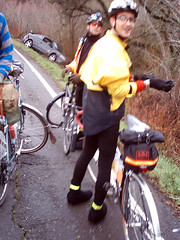 That feeling slipped quickly away about a mile later. As the roadway curved slightly, it was obvious that autos had been stopped, with warning flares deposited on the road shoulder. Accidents on a brevet route are always a bit nervous-making, and I rolled around the stopped cars to the head of the line. Luckily, it turned out to be a single car which had slid off the roadway, with no physical injury to driver. A tow truck was winching the car out of the ditch, and had a cable stretched across the both lanes. Other riders had been held up here, and people were using the time to rehydrate, snap photos and balance loads. We chatted with the ranger who was wrangling traffic. He seemed interested in our ride and pointed out that the section of Sir Francis Drake between Hwy 1 and the Inverness Park curve (locally known as White House Pool) was closed due to flooding.
That feeling slipped quickly away about a mile later. As the roadway curved slightly, it was obvious that autos had been stopped, with warning flares deposited on the road shoulder. Accidents on a brevet route are always a bit nervous-making, and I rolled around the stopped cars to the head of the line. Luckily, it turned out to be a single car which had slid off the roadway, with no physical injury to driver. A tow truck was winching the car out of the ditch, and had a cable stretched across the both lanes. Other riders had been held up here, and people were using the time to rehydrate, snap photos and balance loads. We chatted with the ranger who was wrangling traffic. He seemed interested in our ride and pointed out that the section of Sir Francis Drake between Hwy 1 and the Inverness Park curve (locally known as White House Pool) was closed due to flooding.
This was not great news. That was part of the route on the way back from the Lighthouse. If conditions didn’t get better, we’d have to backtrack a couple miles on Bear Valley Road before heading north again on Hwy 1 to Pt. Reyes Station. But, it wasn’t worth worrying about too much - that part was a couple hours away, and conditions could certainly change.
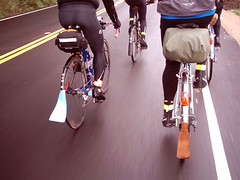 The muddy and bent up “sports car” got dragged unceremoniously over the shoulder, onto the road and down the opposing lane. At that point, the ranger let us through ahead of the waiting cars, and we all pressed forward, anxious to be moving once again. As with all things randonneuring, the clock didn’t stop while we had been waiting.
The muddy and bent up “sports car” got dragged unceremoniously over the shoulder, onto the road and down the opposing lane. At that point, the ranger let us through ahead of the waiting cars, and we all pressed forward, anxious to be moving once again. As with all things randonneuring, the clock didn’t stop while we had been waiting.
As we hit the end of Bear Valley Road, I took a quick glance down the SFD section. Under water indeed, right at the bridge. “Could be tidal,” I thought, before putting it out of my mind. There were other issues to deal with first. Like donuts.
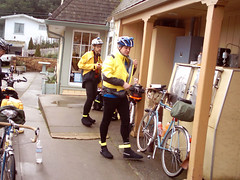 Inverness Park is a wide spot on road, with chubby little pygmy goats on one side, a market/deli and bakery on the other. While I like the diminutive bovids, food and water weighed more heavily on my mind. A number of us pulled off the course and attacked the market like, well, randonneurs. I made sure that my bottles were topped off, and heard a maple old fashioned donut call to me from the case. Others made more aggressive choices, and Carlos negotiated a sandwich to be made in time for his return leg. We moved outside and refilled bottles, ate and psyched ourselves up for the next bits. I’d taken the time to peel off my jacket during the road delay and as my temperature cooled, felt the need to hit the road sooner than most. I also knew we’d eventually be pushing back into the winds and figured that any time benefit would be helpful. John-from -Cool rolled out at about the same time, and we chatted a bit more as we skirted the water of Tomales Bay.
Inverness Park is a wide spot on road, with chubby little pygmy goats on one side, a market/deli and bakery on the other. While I like the diminutive bovids, food and water weighed more heavily on my mind. A number of us pulled off the course and attacked the market like, well, randonneurs. I made sure that my bottles were topped off, and heard a maple old fashioned donut call to me from the case. Others made more aggressive choices, and Carlos negotiated a sandwich to be made in time for his return leg. We moved outside and refilled bottles, ate and psyched ourselves up for the next bits. I’d taken the time to peel off my jacket during the road delay and as my temperature cooled, felt the need to hit the road sooner than most. I also knew we’d eventually be pushing back into the winds and figured that any time benefit would be helpful. John-from -Cool rolled out at about the same time, and we chatted a bit more as we skirted the water of Tomales Bay.
The Inverness climb lay ahead, and I found that with a geared/coastable setup, it was indeed a bit easier than last year. Near the top, I heard breathing, and Carlos caught me - within 50 meters of where he passed me last year. Since I was still on my bike this time, I snuck back up to him on the downhill side and we pedaled west together, with John joining us at the low point at Drakes Bay. The little risers began and my legs felt chunky for a few hundred yards. John and Carlos edged away and I could see a strong crosswind begin catching Carlos’ hair. There are few trees in this section, and as such little to use to judge wind speed. But, climbing up to the first mesa area, the buffeting from the south felt pretty strong.
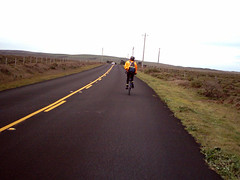 About a 1/2 mile later, the road turned south toward the Lighthouse, and the crosswind became a quartering headwind. It wasn’t actually that big a problem - as road started climbing, it felt more of annoyance than an effect. Still, I caught up with Carlos, John faded back a bit and then Carlos fell slightly behind.
About a 1/2 mile later, the road turned south toward the Lighthouse, and the crosswind became a quartering headwind. It wasn’t actually that big a problem - as road started climbing, it felt more of annoyance than an effect. Still, I caught up with Carlos, John faded back a bit and then Carlos fell slightly behind.
This should probably have been a key bit of evidence. I rarely leave Carlos behind. Now, he wasn’t dropped or anything, and we slinkied and traded positions a few times, but the winds seemed to catch him a bit more than me. It was probably a combination of my gravitational enhancement and low road bars. I spent most of the time deep in the drops, positoned like I was in a criterium. Carlos was riding his Miyata, with flat bars and barends. While it was not easy, the miles went pretty well - my plan for the day had been to push when I felt good and hope that averaged out with the frayed bits when under-mileage reared its ugly head later in the day.
The winds picked up and became more challenging as we got closer to the Lighthouse. I watched the heavy wooden sign at “E” Ranch pushed towards horizontal, had to remind myself not to over-correct against it more than a few times, and got jumped around the road by it pretty well a couple more times. We had stopped commenting on the winds when we caught up to one another, and began gritting our way through it in a purposeful way. A couple other riders began showing on their return leg - it was heartening in the sense that there weren’t a lot of them. Luckily, it didn’t dawn on me the reduction in rider numbers which had taken place this year. On the last section following the steep pitch to the Lighthouse, there were serious crosswinds, and it felt like someone was shaking my front wheel while sand blasted my exposed skin. We passed at least one rider who was walking this section. It was pretty hairy.
 Carlos and I rolled into the parking lot at 11 am. I had the distinct impression of it being difficult to lie my bike down against the winds. Another rider later reported that the rangers had recorded steady winds at 35-40 mph. Mike Biswell snapped photos and exuded happy confidence. Bruce Berg sat in the truck of the car, signing brevet cards and confirming riders’ signatures. I dug my card out and we swapped autographs. Then I carefully returned it to my bag. I’d had a dream earlier in the week about getting all the way back to Inverness and realizing I’d either lost my card or not had it signed. Fun as it had been, I didn’t want to have to backtrack today.
Carlos and I rolled into the parking lot at 11 am. I had the distinct impression of it being difficult to lie my bike down against the winds. Another rider later reported that the rangers had recorded steady winds at 35-40 mph. Mike Biswell snapped photos and exuded happy confidence. Bruce Berg sat in the truck of the car, signing brevet cards and confirming riders’ signatures. I dug my card out and we swapped autographs. Then I carefully returned it to my bag. I’d had a dream earlier in the week about getting all the way back to Inverness and realizing I’d either lost my card or not had it signed. Fun as it had been, I didn’t want to have to backtrack today.
We didn’t want to dally in the blustery cold winds - water in/water out and we hit the road again. I had chugged a protein drink from my bag, happy to shift the dead weight into calories. Right then, it just made sense to get off that point as quickly as possible.
continued…Pt. 2 is here
February 3rd, 2008 at 10:04 am Great story. Inspires me to do something like that when Spring comes to the Northeast (or maybe Summer).
February 4th, 2008 at 2:12 am Great ride report. Kinda wish I had gotten to ride it.
February 4th, 2008 at 11:07 am Great report. I had my bike rain-proofed leading up to it, then chickened out last minute. Maybe I will attempt the 300K!
February 4th, 2008 at 7:48 pm Great story! How do you rate Homer as a Brevet bike? I’m thinking of updating mine and Homer is about the only thing I can buy off the shelf that is likely to come close to fitting. Cheers Steve
February 4th, 2008 at 10:23 pm Been really enjoying the Hilsen. I think any shortcomings (which appear in “Pt 2″…) are a result of the motor, rather than the bike! - J